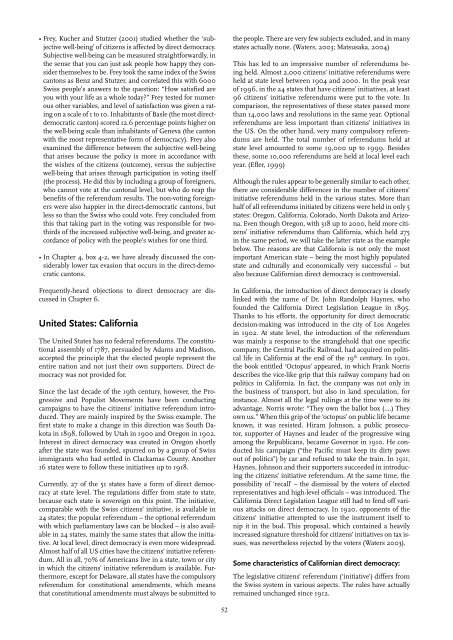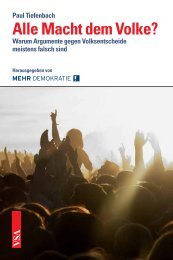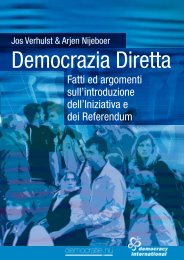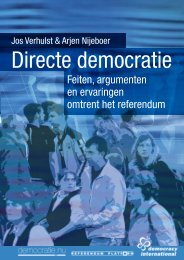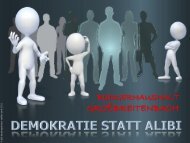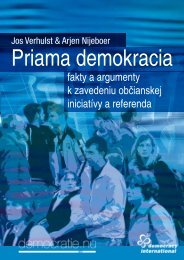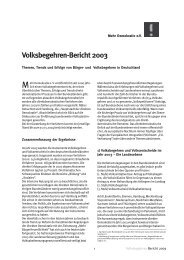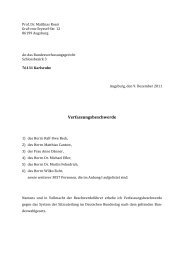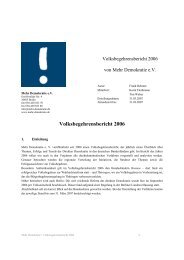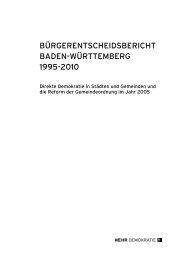Facts and Arguments about the Introduction of Initiative and ...
Facts and Arguments about the Introduction of Initiative and ...
Facts and Arguments about the Introduction of Initiative and ...
Create successful ePaper yourself
Turn your PDF publications into a flip-book with our unique Google optimized e-Paper software.
• Frey, Kucher <strong>and</strong> Stutzer (2001) studied whe<strong>the</strong>r <strong>the</strong> ‘subjective<br />
well-being’ <strong>of</strong> citizens is affected by direct democracy.<br />
Subjective well-being can be measured straightforwardly, in<br />
<strong>the</strong> sense that you can just ask people how happy <strong>the</strong>y consider<br />
<strong>the</strong>mselves to be. Frey took <strong>the</strong> same index <strong>of</strong> <strong>the</strong> Swiss<br />
cantons as Benz <strong>and</strong> Stutzer, <strong>and</strong> correlated this with 6000<br />
Swiss people’s answers to <strong>the</strong> question: “How satisfied are<br />
you with your life as a whole today?” Frey tested for numerous<br />
o<strong>the</strong>r variables, <strong>and</strong> level <strong>of</strong> satisfaction was given a rating<br />
on a scale <strong>of</strong> 1 to 10. Inhabitants <strong>of</strong> Basle (<strong>the</strong> most directdemocratic<br />
canton) scored 12.6 percentage points higher on<br />
<strong>the</strong> well-being scale than inhabitants <strong>of</strong> Geneva (<strong>the</strong> canton<br />
with <strong>the</strong> most representative form <strong>of</strong> democracy). Frey also<br />
examined <strong>the</strong> difference between <strong>the</strong> subjective well-being<br />
that arises because <strong>the</strong> policy is more in accordance with<br />
<strong>the</strong> wishes <strong>of</strong> <strong>the</strong> citizens (outcome), versus <strong>the</strong> subjective<br />
well-being that arises through participation in voting itself<br />
(<strong>the</strong> process). He did this by including a group <strong>of</strong> foreigners,<br />
who cannot vote at <strong>the</strong> cantonal level, but who do reap <strong>the</strong><br />
benefits <strong>of</strong> <strong>the</strong> referendum results. The non-voting foreigners<br />
were also happier in <strong>the</strong> direct-democratic cantons, but<br />
less so than <strong>the</strong> Swiss who could vote. Frey concluded from<br />
this that taking part in <strong>the</strong> voting was responsible for twothirds<br />
<strong>of</strong> <strong>the</strong> increased subjective well-being, <strong>and</strong> greater accordance<br />
<strong>of</strong> policy with <strong>the</strong> people’s wishes for one third.<br />
• In Chapter 4, box 4-2, we have already discussed <strong>the</strong> considerably<br />
lower tax evasion that occurs in <strong>the</strong> direct-democratic<br />
cantons.<br />
Frequently-heard objections to direct democracy are discussed<br />
in Chapter 6.<br />
United States: California<br />
The United States has no federal referendums. The constitutional<br />
assembly <strong>of</strong> 1787, persuaded by Adams <strong>and</strong> Madison,<br />
accepted <strong>the</strong> principle that <strong>the</strong> elected people represent <strong>the</strong><br />
entire nation <strong>and</strong> not just <strong>the</strong>ir own supporters. Direct democracy<br />
was not provided for.<br />
Since <strong>the</strong> last decade <strong>of</strong> <strong>the</strong> 19th century, however, <strong>the</strong> Progressive<br />
<strong>and</strong> Populist Movements have been conducting<br />
campaigns to have <strong>the</strong> citizens’ initiative referendum introduced.<br />
They are mainly inspired by <strong>the</strong> Swiss example. The<br />
first state to make a change in this direction was South Dakota<br />
in 1898, followed by Utah in 1900 <strong>and</strong> Oregon in 1902.<br />
Interest in direct democracy was created in Oregon shortly<br />
after <strong>the</strong> state was founded, spurred on by a group <strong>of</strong> Swiss<br />
immigrants who had settled in Clackamas County. Ano<strong>the</strong>r<br />
16 states were to follow <strong>the</strong>se initiatives up to 1918.<br />
Currently, 27 <strong>of</strong> <strong>the</strong> 51 states have a form <strong>of</strong> direct democracy<br />
at state level. The regulations differ from state to state,<br />
because each state is sovereign on this point. The initiative,<br />
comparable with <strong>the</strong> Swiss citizens’ initiative, is available in<br />
24 states; <strong>the</strong> popular referendum – <strong>the</strong> optional referendum<br />
with which parliamentary laws can be blocked – is also available<br />
in 24 states, mainly <strong>the</strong> same states that allow <strong>the</strong> initiative.<br />
At local level, direct democracy is even more widespread.<br />
Almost half <strong>of</strong> all US cities have <strong>the</strong> citizens’ initiative referendum.<br />
All in all, 70% <strong>of</strong> Americans live in a state, town or city<br />
in which <strong>the</strong> citizens’ initiative referendum is available. Fur<strong>the</strong>rmore,<br />
except for Delaware, all states have <strong>the</strong> compulsory<br />
referendum for constitutional amendments, which means<br />
that constitutional amendments must always be submitted to<br />
2<br />
<strong>the</strong> people. There are very few subjects excluded, <strong>and</strong> in many<br />
states actually none. (Waters, 2003; Matsusaka, 2004)<br />
This has led to an impressive number <strong>of</strong> referendums being<br />
held. Almost 2,000 citizens’ initiative referendums were<br />
held at state level between 1904 <strong>and</strong> 2000. In <strong>the</strong> peak year<br />
<strong>of</strong> 1996, in <strong>the</strong> 24 states that have citizens’ initiatives, at least<br />
96 citizens’ initiative referendums were put to <strong>the</strong> vote. In<br />
comparison, <strong>the</strong> representatives <strong>of</strong> <strong>the</strong>se states passed more<br />
than 14,000 laws <strong>and</strong> resolutions in <strong>the</strong> same year. Optional<br />
referendums are less important than citizens’ initiatives in<br />
<strong>the</strong> US. On <strong>the</strong> o<strong>the</strong>r h<strong>and</strong>, very many compulsory referendums<br />
are held. The total number <strong>of</strong> referendums held at<br />
state level amounted to some 19,000 up to 1999. Besides<br />
<strong>the</strong>se, some 10,000 referendums are held at local level each<br />
year. (Efler, 1999)<br />
Although <strong>the</strong> rules appear to be generally similar to each o<strong>the</strong>r,<br />
<strong>the</strong>re are considerable differences in <strong>the</strong> number <strong>of</strong> citizens’<br />
initiative referendums held in <strong>the</strong> various states. More than<br />
half <strong>of</strong> all referendums initiated by citizens were held in only 5<br />
states: Oregon, California, Colorado, North Dakota <strong>and</strong> Arizona.<br />
Even though Oregon, with 318 up to 2000, held more citizens’<br />
initiative referendums than California, which held 275<br />
in <strong>the</strong> same period, we will take <strong>the</strong> latter state as <strong>the</strong> example<br />
below. The reasons are that California is not only <strong>the</strong> most<br />
important American state – being <strong>the</strong> most highly populated<br />
state <strong>and</strong> culturally <strong>and</strong> economically very successful – but<br />
also because Californian direct democracy is controversial.<br />
In California, <strong>the</strong> introduction <strong>of</strong> direct democracy is closely<br />
linked with <strong>the</strong> name <strong>of</strong> Dr. John R<strong>and</strong>olph Haynes, who<br />
founded <strong>the</strong> California Direct Legislation League in 1895.<br />
Thanks to his efforts, <strong>the</strong> opportunity for direct democratic<br />
decision-making was introduced in <strong>the</strong> city <strong>of</strong> Los Angeles<br />
in 1902. At state level, <strong>the</strong> introduction <strong>of</strong> <strong>the</strong> referendum<br />
was mainly a response to <strong>the</strong> stranglehold that one specific<br />
company, <strong>the</strong> Central Pacific Railroad, had acquired on political<br />
life in California at <strong>the</strong> end <strong>of</strong> <strong>the</strong> 19 th century. In 1901,<br />
<strong>the</strong> book entitled ‘Octopus’ appeared, in which Frank Norris<br />
describes <strong>the</strong> vice-like grip that this railway company had on<br />
politics in California. In fact, <strong>the</strong> company was not only in<br />
<strong>the</strong> business <strong>of</strong> transport, but also in l<strong>and</strong> speculation, for<br />
instance. Almost all <strong>the</strong> legal rulings at <strong>the</strong> time were to its<br />
advantage. Norris wrote: “They own <strong>the</strong> ballot box (….) They<br />
own us.” When this grip <strong>of</strong> <strong>the</strong> ‘octopus’ on public life became<br />
known, it was resisted. Hiram Johnson, a public prosecutor,<br />
supporter <strong>of</strong> Haynes <strong>and</strong> leader <strong>of</strong> <strong>the</strong> progressive wing<br />
among <strong>the</strong> Republicans, became Governor in 1910. He conducted<br />
his campaign (“<strong>the</strong> Pacific must keep its dirty paws<br />
out <strong>of</strong> politics”) by car <strong>and</strong> refused to take <strong>the</strong> train. In 1911,<br />
Haynes, Johnson <strong>and</strong> <strong>the</strong>ir supporters succeeded in introducing<br />
<strong>the</strong> citizens’ initiative referendum. At <strong>the</strong> same time, <strong>the</strong><br />
possibility <strong>of</strong> ‘recall’ – <strong>the</strong> dismissal by <strong>the</strong> voters <strong>of</strong> elected<br />
representatives <strong>and</strong> high-level <strong>of</strong>ficials – was introduced. The<br />
California Direct Legislation League still had to fend <strong>of</strong>f various<br />
attacks on direct democracy. In 1920, opponents <strong>of</strong> <strong>the</strong><br />
citizens’ initiative attempted to use <strong>the</strong> instrument itself to<br />
nip it in <strong>the</strong> bud. This proposal, which contained a heavily<br />
increased signature threshold for citizens’ initiatives on tax issues,<br />
was never<strong>the</strong>less rejected by <strong>the</strong> voters (Waters 2003).<br />
Some characteristics <strong>of</strong> Californian direct democracy:<br />
The legislative citizens’ referendum (‘initiative’) differs from<br />
<strong>the</strong> Swiss system in various aspects. The rules have actually<br />
remained unchanged since 1912.


